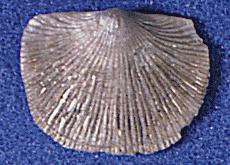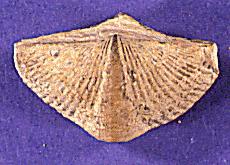Natural weapons of mass extinction receive a lot of scientific and media attention; from doomsday asteroids and comets to supervolcanoes and tsunami. Despite such cataclysmic occurrences, certain natural events that are normally associated with the disappearance of countless species, Ice Ages for instance, do not affect all organisms equally.
Take the Great Ice Age of 330 to 290 million years ago. During this period, the rates of extinction are, puzzlingly, much lower than scientists might have expected for many of the major groups of marine animals. Now, a graduate student at the Johns Hopkins University has come up with a likely answer. The aquatic life forms that survived this frozen epoch late in the Palaeozoic Era were those that were best equipped to endure severe fluctuations in temperature and sea levels. The others followed the way of the dinosaurs and the dodo.

Strophex brachiopod, courtesy UC Museum of Paleontology
It is true that the species that survived the onset of the Ice Age were those best adapted to the Ice Age conditions, JHU doctoral candidate Matthew Powell told Spotlight. The main point is not that I demonstrated that climate influences the composition of the biota, but that I linked these changes to global macroevolutionary rates (macroevolution equals rates of speciation and extinction). This is the first study that causally links climate to macroevolutionary patterns over such a long interval of geologic time. It is also the first to examine geographic patterns of macroevolutionary rates over a long time span. These results not only clue us in to what happened many millions of years ago, but they also have implications for understanding the modern marine ecosystem, explains Powell.
Powell examined extinctions that occurred when glaciers extended to within 35 degrees of the equator and looked the extinctions occurring in species of the brachiopods, simple shelled sea creatures. He constructed a database that charted latitudinal patterns of evolution and extinction through the late Palaeozoic. This database is the first ever; no other database of this kind exists for any interval of geologic time, from which to study geographic patterns of macroevolution, Powell said. His analysis revealed that brachiopods that lived primarily near the equator suffered the highest extinction rates and did not re-appear in great numbers until the Ice Age ended. The absence of these particular brachiopods during the Ice Age left the oceans populated almost entirely with those who lived over a wider geographic area, Powell said; those that were presumably capable of surviving wider temperature ranges in the more temperate and seasonal climes away from the equator.

Spirex brachiopod, courtesy UC Museum of Paleontology
Brachiopods, which resemble clams but are a distinct group, still exist today. Brachiopods are no longer as abundant as they were in the Palaeozoic, says Powell. They are most abundant now around New Zealand, but they do occur worldwide. Nevertheless, Powell’s research into ancient life may have implications for research into the fate of modern marine life. If the patterns I detected also are true for the modern Ice Age – and other researchers’ results suggest that they may be – then modern marine life ought to be relatively resistant to extinction, Powell adds. However, species are dying off at much faster than ancient survival rates suggest they should. It might be that environmental change caused by human activity has disturbed those species that the data suggest should be relatively immune.
Further reading
Geology, 2005, 33, 381-384
http://dx.doi.org/10.1130/G21155.1
Introduction to the Brachiopoda
http://www.ucmp.berkeley.edu/brachiopoda/brachiopoda.html
Suggested searches
Palaeozoic
brachiopods
Ice Ages